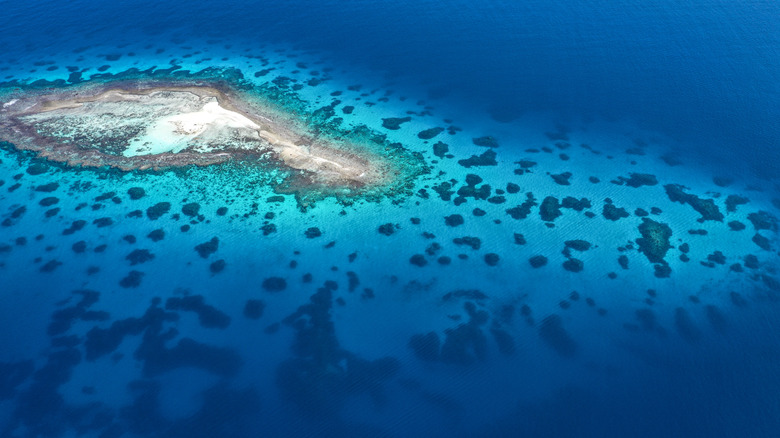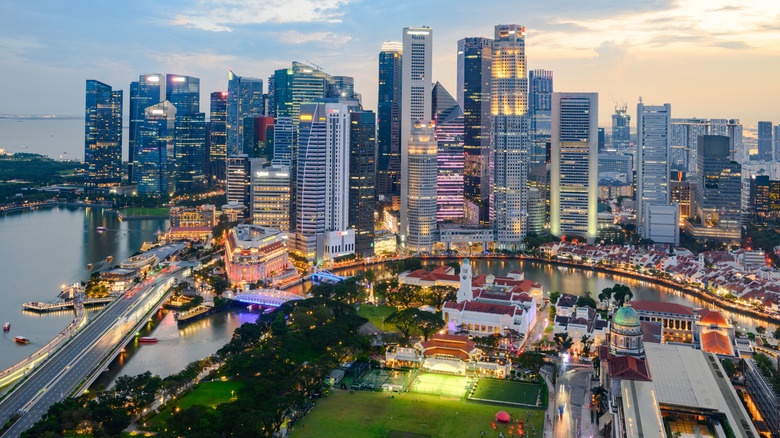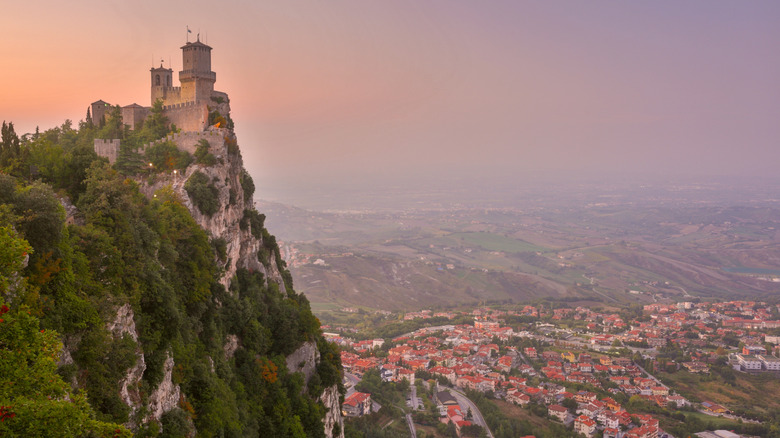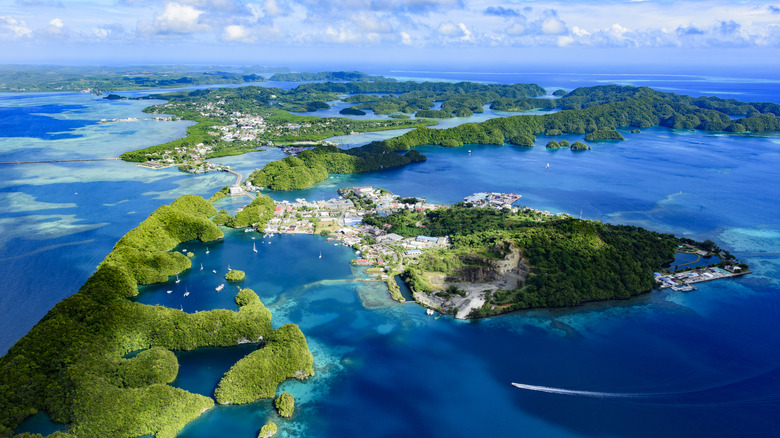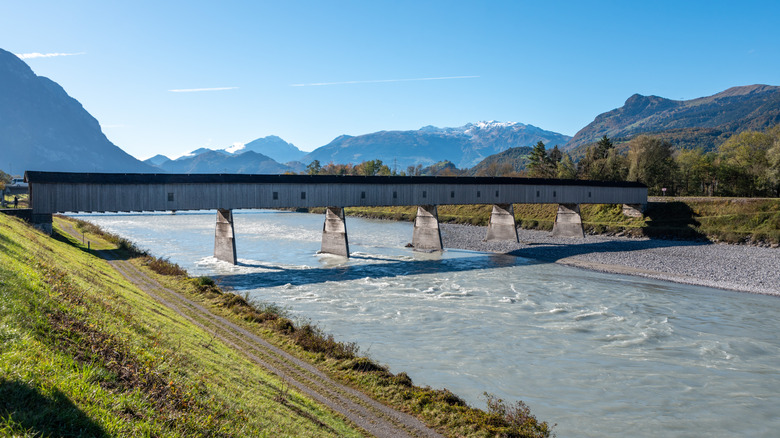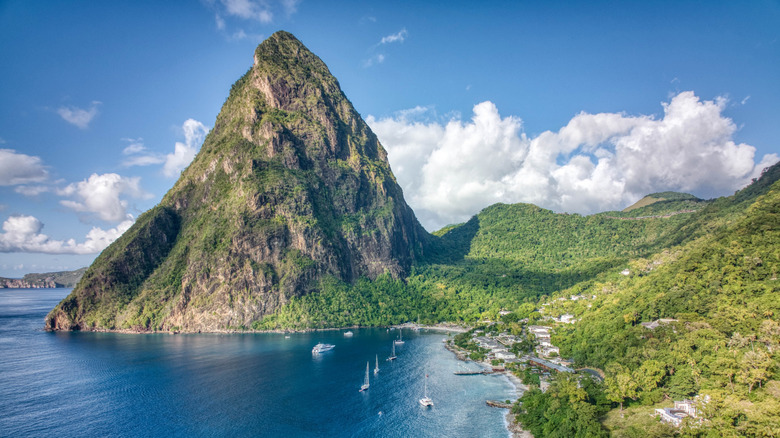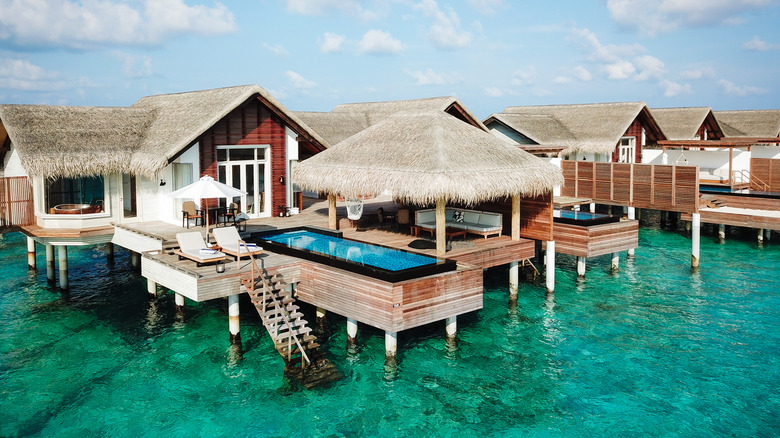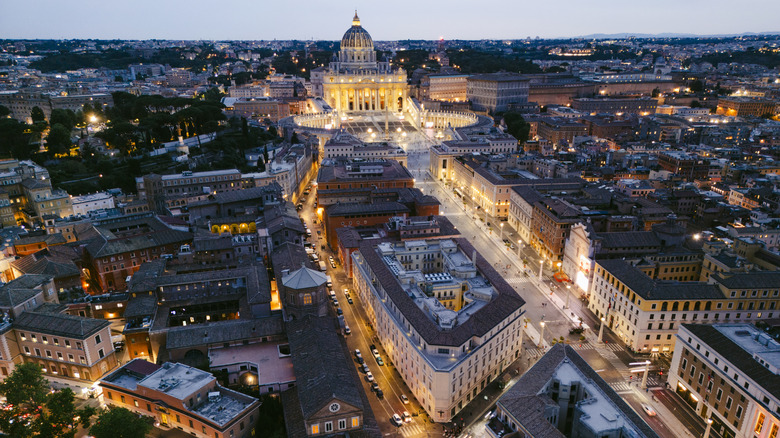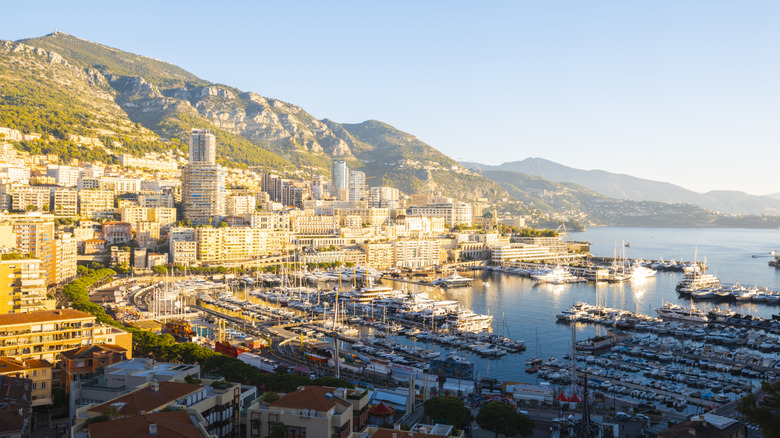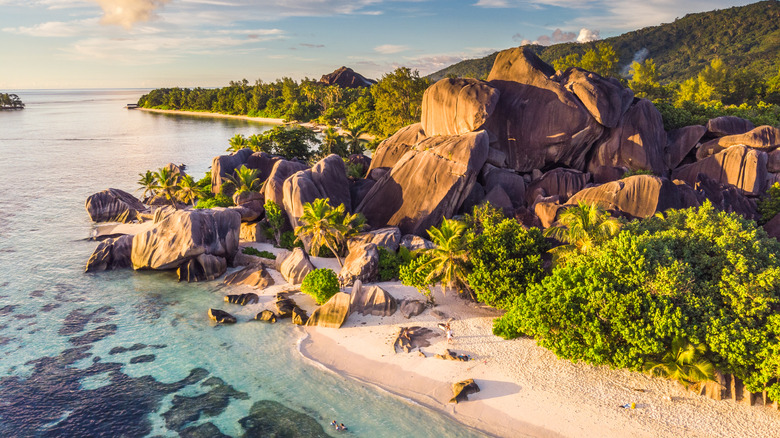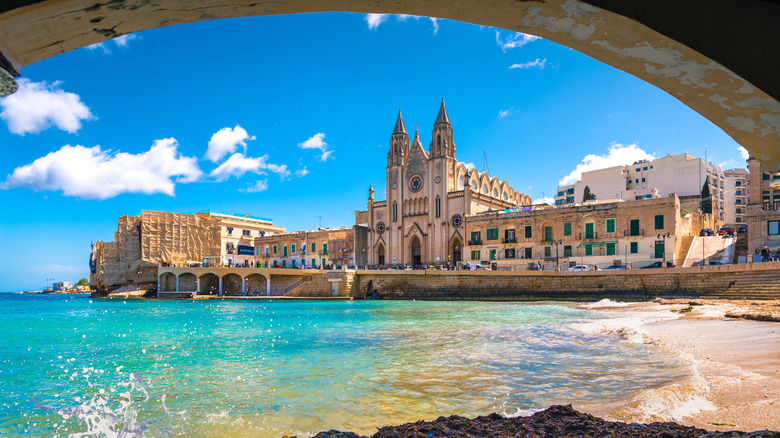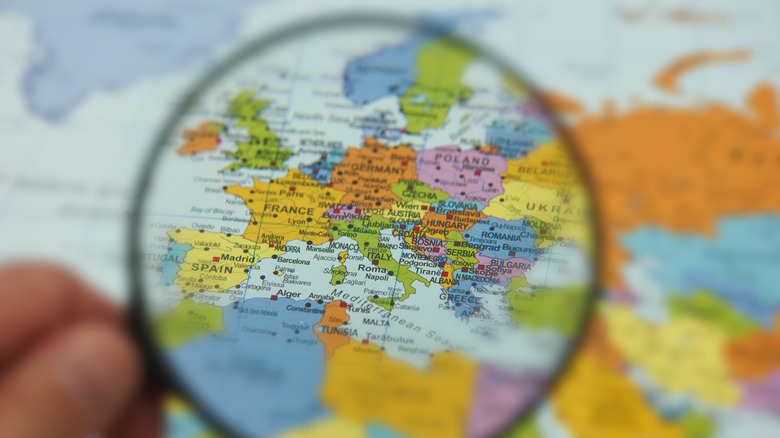These Tiny Countries Became Some Of The Biggest Tourist Hotspots In The World
There's a slight paradox when it comes to searching for that perfect getaway. The more popular the destination, the larger the influx, the larger the influx, the less desirable said location becomes. Sure, there are tips for avoiding Europe's most popular hotspots, places you should visit once the crowds have left, and some out-of-the-way spots kept on a deliberate downlow. Sometimes such tactics work, sometimes they do not.
But there is another subsection of the travel industry that lives with one foot in both camps: Locations so small that they are at once half-forgotten and desperately popular at the same time. In some cases, they suffer from the most dreadful overcrowding. In others, a genuine feeling of exclusivity permeates. True, there are places that might feel overpopulated with only a few hundred people present. But there are also forgotten locations that never see half that many gathered at any one time.
This list details some of the smallest countries in the world, yes, but it does so with an eye on those locations that are well worth a visit. Where overcrowding is an issue, steps have been taken to offer guidance on how to navigate such headwinds. Where it is more of a question of the country simply being a lesser-known gem, time has been taken to explain why such locales hit so far above their weight.
Singapore
There are few places in the world quite so unique as Singapore. With a population of over six million squeezed into less than 300 square miles of extremely expensive real estate, Singapore is reminiscent of one of those city-states of antiquity. Yet here we find a city-state steeped in modernity, and one that outperforms its diminutive stature. The nation is small, but wealthy, with one of the highest GDPs per capita in the world.
It's also something of a tourist hotspot, with close to 17 million visitors in 2024. Singapore's airport is one of the busiest in the world, acting as a transport hub between Asia and Oceania. Visitors from the United States can stay over for up to 90 days without a visa, affording them plenty of time to see all that Singapore has to offer.
It is, after all, a global nexus of fine cuisine, urban sprawl, and ultra-modern practicality. With little effort, you can find yourself wandering through the exquisite gardens overlooking Singapore's magnificent bay or discovering new culinary delights at the Lau Pa Sat Market. Festivals are frequent; some of the largest are genuine city-wide celebrations. You can escape the city by visiting nearby islands that teem with wildlife, or walk the streets of Little India in search of an unforgettable keepsake. The Formula One season is hectic, and the twin annual monsoons are not for the faint of heart. Thankfully, there's a narrow window that avoids all these things; mid to late spring is a sweet spot.
San Marino
San Marino is one of the smallest countries in the world. It occupies just 23.6 square miles of mountainous real estate and is home to a population of around 33,000 people. It also brings in around two million tourists annually. Visitors flock to the tiny republic to bask in the majestic views, immerse themselves in a nation that drips with medieval vibes, and sample some of the country's unique gastronomic delights. Situated 17 miles from the beautiful beach town of Rimini, Italy, day trips are a definite option, although there are a number of great hotels in situ with competitive off-season prices.
In terms of what to see, the country is so small that most things will be difficult to miss. The three iconic towers are the main draw. Gaita is pentagonal and of 11th-century vintage. Fratta is the highest of the three, standing almost 2,480 feet above sea level. This tower was also built in the 11th century, and today, you'll find the rather excellent Museum of Ancient Arms hidden inside. The third tower, Montale, is of the most recent vintage, having been built in the 13th century. Smaller in stature, a hike up there takes about 75 minutes using the city center as a starting point.
The summer months draw in the largest crowds, so day trippers would do well to arrive as early as possible. A more workable solution is to head over in early to mid-spring or during the fall. You'll find spring temperatures hover around the 60 degrees Fahrenheit range, although the autumnal heat skews a little warmer than that.
Palau
Some 340 islands make up the country known as Palau. On an atlas, it looks like a mere speck adrift in a near-forgotten southwest corner of Micronesia. It has a population of around 18,000 people and a total landmass of just 188 square miles. It is, without question, one of the best-kept secret travel destinations in the world.
The number of tourists fluctuates year on year, but hit an all-time high of 168,000 visitors in 2015. Most came to enjoy the incredibly clear blue waters surrounding the archipelago and indulge in some of the finest diving in the whole world. There are coral gardens to explore, lagoons that teem with jellyfish, and shipwrecks to marvel at. During the dry season — November to April — the sea is tranquil, and visibility can extend to as much as 100 feet. The water is also warm, around 82–86 degrees Fahrenheit year-round. It's picture-perfect to be sure, and the islanders have made it clear that they intend to keep things that way. Indeed, the small nation takes its ecological heritage so seriously that visitors need to sign a pledge to protect the nation's delicate ecosystem as a prerequisite to travelling there.
The main island has its own airport, and although there are no direct flights from the U.S., links to Manila, Guam, or Papua New Guinea are available. Hotel prices are more reasonable than you might expect, even during the busy season.
Liechtenstein
Liechtenstein is the fourth smallest country in Europe and the sixth smallest in the world, with a population hovering around the 40,000 mark. With its breathtaking mountain views, Liechtenstein is a hub of winter sport activity, a great place to go hiking, and a country steeped in historical timbre. It's also rich: Liechtenstein's per capita income averages over $200,000 each year, making it the second-wealthiest country in Europe. The population more than doubles each day as some 45,000 commuters cross the border from neighboring countries. EU citizens don't require a work permit, and since wages are high and jobs are plentiful, it's easy to see why so many make the commute.
Exploring its 62 square miles is more of a challenge than you might think. Vaduz Castle dominates the landscape and is visible for miles around. As the official residence of the country's ruler, the Prince of Liechtenstein, tours are not allowed, but the castle provides a cinematic ambience when viewed from afar. Gutenberg Castle, on the other hand, is a consummate crowd pleaser. Built on a most ancient and distinctive hill, the fortress offers panoramic views of the entire nation as well as of the Rhine as it meanders south. Meanwhile, nature lovers can journey to the nation's northern nature reserve. Here, the Rugel Wetlands offer a chance to view exotic wildflowers and incredible fauna. In May, the Siberian iris blossoms, while year-round, hard-to-spot fauna, including kingfishers, whistling marmosets, and ibex, are a genuine delight.
Best of all is the fact that Liechtenstein is one of the least visited countries in Europe and is rarely overcrowded. Tourist arrivals hover around the 100,000 a year mark, meaning that at any given time, you are likely to have the place to yourself. Relatively speaking, of course.
Saint Lucia
Northwest of Barbados sits the tiny island of Saint Lucia. Culturally, it is a heady mix of native Carib blended with African culture and influenced by successive waves of British and French colonizers. Famed for its UNESCO World Heritage-approved Pitons Management Area, featuring two volcanic spires — both of which you can hike — the island itself is a mere 188 square miles in total and hosts a population of around 180,000 people; some years, more than three times that number visit.
It's little mystery why people make the pilgrimage. The island is blessed. Lush tropical forests dot the landscape. Mirror-clear waters teem with technicolor marvels. The average temperature hovers around 73 degrees. It all works in tandem with an inviting culinary scene that melds freshness and flavor into a unique celebration of its eclectic past. There are must-see picturesque waterfalls to take in, crumbling forts that once saw battle with pirates, and black volcanic sand beaches that are ideal for snorkeling. Meanwhile, Marigot Bay is a haven of yachts, indulgent accommodation, and waterfront dining. It's postcard-perfect to the nth degree, but you'll also find some rough and ready nature trails to snap you back into reality if all that luxury starts to go to your head.
Crowds are an issue during the peak season, which runs from December to April, but you can find deserted spots even outside of the shoulder seasons. Rainfall is heavy during the summer months, but November offers a reprieve; dry, warm, and not yet flooded with tourists, it's a great compromise break for those who crave the quiet life.
Maldives
The Maldives sprawls 34,750 square miles, starting with a chain of islands off the coast of Sri Lanka that extends south all the way to the equator. Only 115 square miles of the area is dry land, though; the rest is nothing but ocean. Any list of what to do in the Maldives is, of course, dominated by all that water, and any attempt to visit every single one of the 1,192 islands is doomed to failure (especially as most of them are uninhabited). Not that this prevents anyone from enjoying some of the many highlights along the way.
It's important to choose the right Maldives island for your vacation, as not every island has the same offerings. There are exclusive resorts to choose from, catering to a range of budgets, alongside hotels and guesthouses aplenty. For those with a little wanderlust in their nature, liveaboard yacht experiences offer a perfect respite from the usual beach and sun vacation. Some offer incredible spa treatments as they roam the region, while others specialize in scuba excursions.
Regardless, the Maldives is a place to swim with sharks, to take the time to explore equatorial fauna, and, yes, to lounge around on white sandy beaches doing as little as possible. There are coral reefs to discover, mangrove swamps to navigate, and enough biodiversity to make David Attenborough's head spin. With a population of over half a million and annual visitations sitting at over four times that figure, the sheer number of islands means that finding a quiet spot is rarely an issue.
Vatican City
The fact that Vatican City is the smallest country on the face of the planet is one of those facts that everyone seems to know. An enclave nestled within Rome with only 0.17 square miles of real estate to play with and a population of around 800, it's near custom-made for dinner party statistics. As the headquarters of the Roman Catholic Church, it's no surprise that the birth rate is zero and the population is mostly male, most of whom are middle-aged — the average age of residents is 57 years old, making it the most elderly population in the world. Home to a priceless collection of art, the Vatican is all that remains of the once vast papal states that past popes once ruled.
It's all very impressive, and the seven million or so tourists who flock to the micronation every year can hardly be blamed. The Sistine Chapel is the most obvious draw, but there's also Saint Peter's Basilica. You'll find rooms decorated by none other than Raphael himself, the Gallery of Maps, and a chance to cast your eyes over the Vatican Library, which has been standing since 1475. While the library is only open to those who can show genuine scholarly need, the building itself is a sight to see.
That it is the most overcrowded tourist spot of all is hardly a surprise given its size and its status as the seat of one of the world's major religions. Getting there early is of some help, as is visiting it during off-peak seasons — which run from April to May and September to October. Security is tight regardless, and there are one or two unexpected items that you can't take in there with you.
Monaco
With only 0.8 square miles to its name and a population of just 36,000 people, Monaco is only slightly larger than the Vatican yet much more densely populated. A constitutional monarchy, the current prince, Albert II, acts as the head of government and has significant political power. Still, GDP reaches beyond the $10 billion mark with much of the money flowing in from its robust financial and insurance sector.
Tourist numbers are in excess of 300,000 most years, with two principal reasons for visiting. The Monaco Grand Prix takes place in late May or early June; tickets are anything but cheap, and for most people represent a once-in-a-lifetime opportunity to see something special. Casinos are also part of the Monaco experience, and few offer quite as much grandeur as the Casino de Monte Carlo itself. Meanwhile, the Palace of Monaco is as alive with frescoes and hidden treasures as it is ringed with queues during the summer season. It's one of a kind, though, with foundations dating back to the 13th century, and is worth the wait.
Still, for all the grandeur, there remains a wholesome nature to Monaco, making it ideal for a luxurious getaway for solo travellers. There are museums, just as you'd find in any other high-volume tourist area, and the Café de Paris remains to this day one of the best spots to enjoy a quiet lunch in all of Europe. The prices are high, of course, but not absurdly so. It's worth treating yourself.
Seychelles
One of the Indian Ocean's most beautiful sights — and one of the smallest countries in the world — is Seychelles. As far as hidden gem islands you should add to your bucket list go, Seychelles has nearly cornered the market. There are 115 islands in total; two are large, relatively speaking, of course, while the rest alternate between mountainous terrain and islands made entirely of coral. Still, the actual landmass is less than 170 square miles, and the entire population of 121,000 people is outnumbered almost three to one when it comes to annual visitations.
Of course, there is little mystery as to why so many people flock to the region. To begin with, as islands getaways go, arriving is relatively straightforward. Flights from the U.K. take around 10 hours; journeys with layovers in Dubai or Abu Dhabi take a little longer. Getting to the archipelago from the U.S. is more complicated; the non-direct Chicago O'Hare is a popular choice here with a flight time of around 19 hours.
Once there, settling into the slower pace of life is an absolute breeze. Beaches are things of granite, palm trees, and sand milled into fine powder. Excursions towards the outer islands reveal magnificent atolls teeming with wild tortoise, azure lagoons, and exotic, nesting seabirds. Closer to home base, the nightlife is vibrant and the Creole-influenced cuisine an absolute delight. Rain showers during high summer — December through February — are common, and things can get a little bit toasty. April, May, October, and November, on the other hand, are drier, and although still warm, the heat is generally manageable.
Malta
Fewer than 600,000 people call Malta — a Mediterranean archipelago with a mere 122 square miles of total land area — home, yet it welcomes over three million visitors to its shores every year. South of Sicily, yet only a couple of hundred miles from the north African coast, temperatures average out in the low 80s during peak summer months. and crowds become a serious issue.
Fine weather is certainly one of the main reasons people flock to Malta — it has 122 miles of shoreline, and beaches are plentiful. But it has a lot more to offer than that. Certainly, thrill seekers should consider Malta for their next adrenaline rush; climbing limestone cliffs, hiking through rugged terrain, diving in the clear waters, and quad bike tours are all the rage here. History buffs are also well-served by the island nation. There are megalithic temples older than Stonehenge, half a millennium's worth of stories to unravel in the Grand Master's palace, and the astonishing decadence of Saint John's Co-Cathedral to take in.
With so much to see and do, it almost goes without saying that you should plan to visit during the shoulder season. A winter break is not out of the question, but it leans towards chilly most days. A spring visit is more in line with what you'd want from a Maltese getaway, with April finding itself as something of a sweet spot.
How we compiled this list
We cross-referenced nations based on size, population, and tourist numbers to produce a selection of genuine hotspots. The final list is comprised of places worth visiting in their own right rather than simply skewing the results to the smallest places possible.
